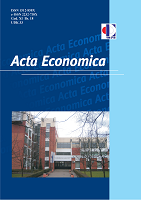Савремена парадигма задуживања као лекција научена током глобалне финансијске кризе
The modern paradigm of borrowing as a lesson learned during the global financial crisis
Author(s): George W. Kester, Goran RadivojacSubject(s): National Economy, Supranational / Global Economy, Political economy, Financial Markets, Socio-Economic Research
Published by: Економски факултет Универзитета у Бањој Луци
Keywords: Debt; banks in the Republic of Srpska; 5C;
Summary/Abstract: According to data published by the Statistical Office of the Republic of Srpska, Gross Domestic Product (GDP) of the Republic of Srpska recorded a negative growth rate of 0.9% in the third quarter of the year 2012. compared to the same period of the year 2011. Th is continued a decline in GDP, which is recorded in two quarters of the 2012. On the other hand, a report by the Statistical Offi ce said that the greatest GDP growth occurred in financial intermediation by 7.6%, which is explained by increased public sector demand for money in order to finance the current budget deficit. Consequently, in practice, we often hear same question in context of the borrowing dilemma - where are the limits of borrowing? Simplified approach in seeking answers to the previous question suggests that the borrowing capacity depends on the estimated value of the collateral of credit arrangement. However, the answer to this question should be sought thorough the analysis of the borrowers cash flows (inflows and outflows), and on the basis of such results we have to do serious examination of the abilities of borrowers capacity to repay their loans from cash flows in the future period of time.
Journal: Acta Economica
- Issue Year: 11/2013
- Issue No: 18
- Page Range: 239-252
- Page Count: 14
- Language: Bosnian, Croatian, Serbian

